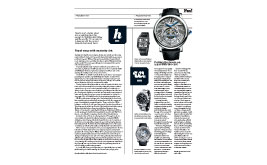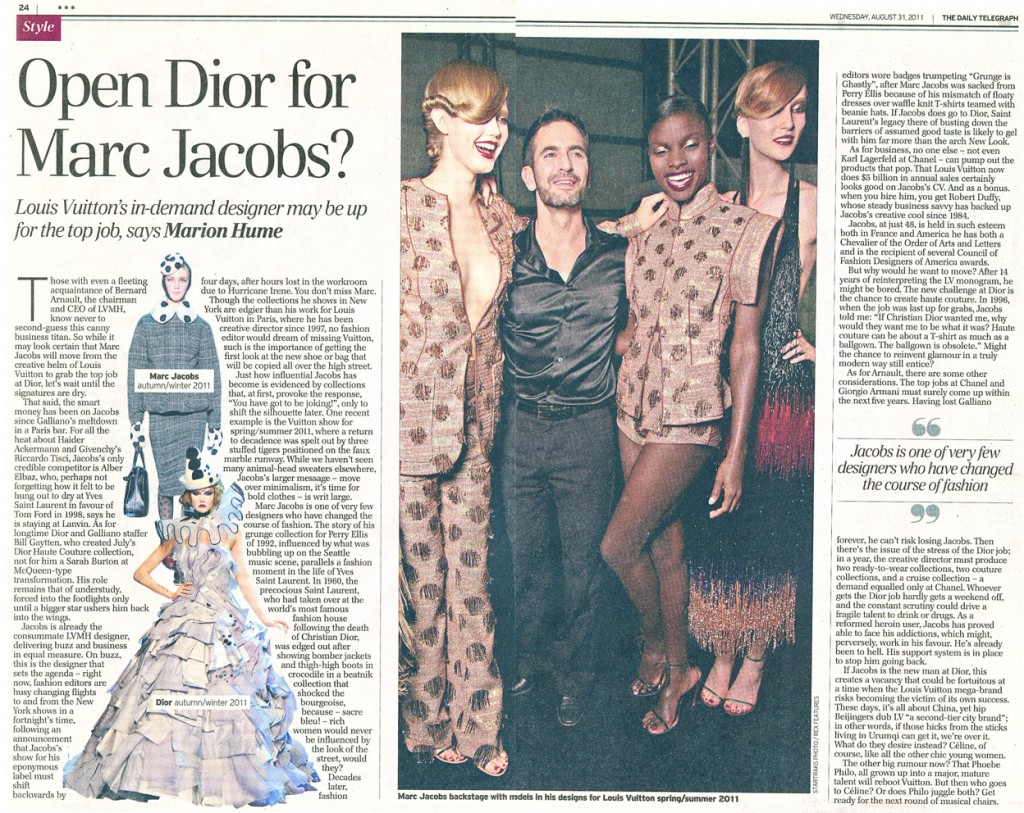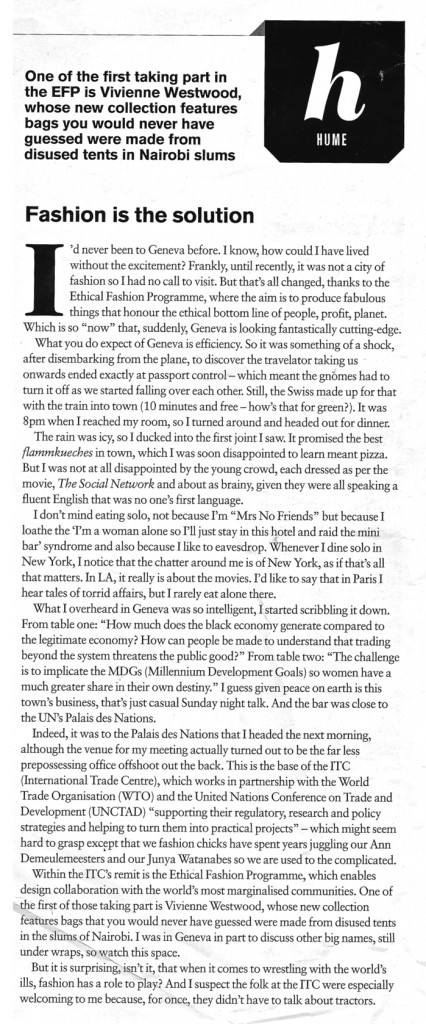Category Archives: Columns
Fashion Is The Solution – AUSTRALIAN FINANCIAL REVIEW
A Lesson Learned – AUSTRALIAN FINANCIAL REVIEW
A Lesson Learned
A gaggle of women in full-on African dress were utterly perplexed by a moving staircase going up to the stars. One gingerly places a foot on a tread, shrieked and fled.
AFR | August 2011
by Marion Hume
Before reaching air-side at Kenyatta International Airport, I was halted at a security desk manned by those doing something most unusual for their rather serious job; they were giggling. It’s true the scene ahead was, in a purely slapstick sense, rather funny. A gaggle of women in full Africna dress were utterly perplexed by a moving staircase going up to the stars. One gingerly places a foot on a trend, shrieked and fled. Another started slapping the rubber handrail as if it were a snake she must kill to stop it moving-at which point the immigration official who had raised his arm to stamp my exit visa bit into his sleeve to stop himself laughing out loud.
Passport stamped at last, I walked towards the high escalator and stepped on to it to gasps of astonishment. Next, a young girl was behind me, shrieking with glee. “See, it’s OK,” I said, before raising my right leg slowly , indicating how to step off again. While I was running late for the Nairobi-London night flight, I hung around just long enough to see others of the group emerge over the top from what. by the look on their delighted faces, has been the ride of their lives.
We all travel so much these days, it’s a struggle to remember our own first time. But to travel, to transit your fist airport, to fly, when you come from a country mired in poverty, is an even more extraordinary thing. Of course not even Kenyan is poor- far from it- but my sense was these women were certainly not Nairobi cosmopolitans. By the time they reached the top of the escalator, their eyes were sparkling with both astonishment and a sense of achievement. They’d conquered something and they hadn’t even left the country.
Still, one must always be wary of stereotyping. I recently worked with a Kenyan cameraman who told me how an international director had shown him some footage shot by his foreign team. Seeing a filthy little toddler digging in the mud with a stick, the cameraman suggested it might not be a great idea to use that sequence but was ignored.
Months later, a mother watching her flat screen TV was furious when she spotted her son being used in one of those bulletins urging us to flex out credit cards for charity. “Don’t those people’s kids ever sit in the yard?” she shouted. (That, and demanding to know why, when the images of kids from rich countries are protected, no one though to so much as ask whether a mother might be equally protective of her little boy). The cameraman said he’d heard that parents in New York and London have become so scared, they never let their kids just be kids, sitting in the sun digging for worms.
Wherever my escalator ladies were headed, I hope there are people to guide them through the subtleties of their new location. For while I was only able to teach them the not wildly complicated skill of how to ride an escalator, what they gave me in exchange was more profound.
If we are lucky in our working lives, we are forever fronting up to new experience. Yet sometimes, I know that makes me nervous and now I now realise that the terminology we use is partly to blame. Why would I relish risking going ‘out on the wire’ when I lack the balancing skills of a circus performer? But stepping on to an escalator, going up? I can do that. So from now on, I’m going to remember the Kenyatta escalator ladies when I need reminding that the new isn’t always to be feared. It can be fun.
Royal Ways with Austerity chic – Australian Financial review

AFR | April 2011
Royal Ways with Austerity Chic
by Marion Hume
There’s much chatter about how a wedding dress big enough for Westminster Abbey and the world’s TV can also be in keeping with the current make-do-and-mend trend.
Austerity Chic: that’s the term being bandied about to describe a forthcoming royal wedding of which, even if you are the staunchest republican, you cannot be unaware. Wills and Kate are doing a buffet, we hear, but there’s much chatter about how a wedding dress big enough for Westminster Abbey and the world’s TV screens can possibly also be in keeping with the current make-do-and-mend trend.
I’m guessing that the royal couple have advisers they can call on in such circumstances, but they could still learn a trick or two from my friends A&M and N&M, as both these couples have recently scored 100% on the Austerity Chic wedding monitor of my own invention.
I doubt W&K – as I shall henceforth call them, for balance – can manage to pair things back quite the way A&M did; their invitation consisted on him saying “Can you meet me at the Civic Centre on Tuesday morning?” -and there he was on the steps, in the suit he was given 15 years ago when he first came to England and got a job as a silver service waiter.
The ring was his mother’s, the bridal car – this will explain the initials – had been borrowed for a test drive from a swanky dealer, the pictures were taken outside Kenwood, one of London’s grandest wedding venues although we didn’t go in, the champagne was concealed in my handbag and the cake was a pile of meringues bought from a local cafe. As for the dress, it was in shades of oyster and chocolate, chosen by a woman who rarely gets new clothes to be worn again. All in all delightful and in the nicest way, spectacularly cheap.
N&M’s wedding was on a bigger scale. Hundreds packed the church and later, a scruffy music venue which had been transformed with elbow grease and ropes of circus lights into a magical place. The groom’s dad is of Welsh heritage, so we kicked off with cups of tea, rounds of sandwiches and slices of Victoria sponge cake that he and his side of the family had made that morning. Mother-of-the-bride is from Sierra Leone, Mother-of-the.groom from Barbados. I’m prepared to wager that the African & Caribbean buffet they cooked up later, and which the bridesmaids ladled out, will outdo W&Ks for flavour – even with all the organic produce from Prince Charles’ farms.
Another bet I know I’ll win is on the dancing. Posh ‘Hoorays’ tend to be commendably enthusiastic but really bad dancers, in contrast to N&M’s celebration where Granny-of-the-bride cleared the dance floor out of respect when she did her moves wearing flame orange robes, a vivid head scarf and a jaunty fedora hat atop it all. The bride’s dress? Cocktail length and one of those rare ones where you think “she really could dye that and wear it afterwards.”
But how can you do “Austerity Chic” when you are marrying the heir to the heir of the throne? Kate’s dress has to be sort of grand; companies such as 9th generation silk weavers, Stephen Walters & Sons, keep going in part because of royal trade, but (please) there has to be less of it than there was of Di’s gown. Dyeing and reshaping is not an option for what is, after all, a future historical artifact, but then, that’s austerity points scored for the guarantee of a second life, viewed under glass. Where Kate’s outfit-to-be is all set for maximum points on my Austerity Chic wedding monitor is in the jewels department. After all, the ring A gave M was only second hand. And those royal tiaras get hauled out and remodelled generation after generation.
So overall, W&K may score higher than you might expect, familiar as they are with the Austerity Chic mantra; Reduce, Recycle, Reuse.


